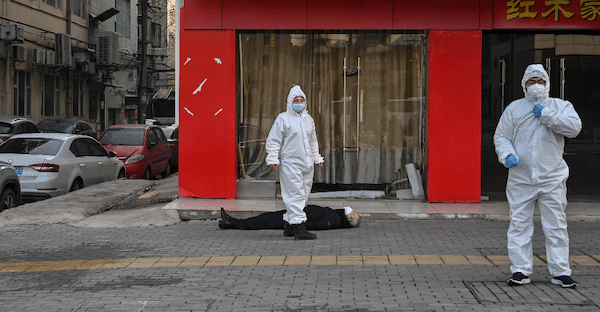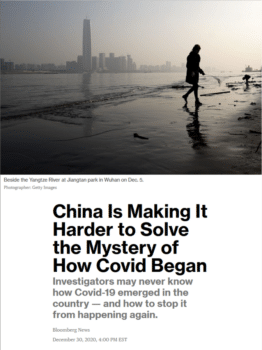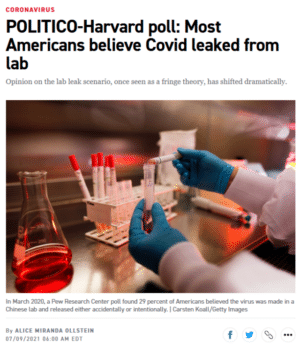
Politico (7/9/21) reports that “what was once a fringe belief held mainly among some on the political right has become accepted by most Republicans, as well as most Democrats, amid heightened scrutiny of the lab leak theory.” Yet “scrutiny” is exactly what the lab leak theory isn’t getting.
FAIR (10/6/20, 6/28/21) has previously critiqued Western news media’s credulous coverage of evidence-free “lab leak” speculations. One key factor in spreading suspicion that the coronavirus might have escaped from the Wuhan Institute of Virology (WIV) is media’s early and ongoing politicization of the World Health Organization’s investigation into the pandemic’s origins. Much of this politicization weaponizes Orientalist tropes about China being especially, perhaps genetically, untrustworthy—the sort of people who would unleash COVID-19 on the world.
While no new evidence has emerged suggesting that the virus emerged from the WIV, many more Americans now believe it did. A Politico/Harvard poll in July, following an increase of uncritical Western media coverage on the lab leak theory, found that 52% of U.S. adults now believe COVID-19 leaked from a lab, up from 29% in March 2020. This is contrary to the assessment of most scientists, who believe, based on available evidence, that a natural origin for the virus is more likely.
At the center of the search for the virus’s origins is the WHO. Its initial investigation, which ended in February 2021, concluded that the lab leak hypothesis was “extremely unlikely.” Shortly afterwards, however, WHO director general Tedros Adhanom Ghebreyesus stated that although the lab leak theory is the least likely cause of the pandemic, it nevertheless “requires further investigation,” and that “all hypotheses remain on the table” (BBC, 3/31/21). The WHO is now calling for WIV laboratory audits and access to raw data from China, with Tedros claiming that attempts to rule out the lab leak theory were “premature” (France24, 7/16/21, 7/16/21).
In a rejection of WHO requests for greater “transparency” and “access” in its proposed plan for the second phase of the origins investigation, the Chinese government reemphasized its preference that the second phase of the WHO investigation focus on further research around possible pre-Wuhan Covid cases globally.
Was China ‘stalling’ investigation?
Early news reports about potential WHO investigations into pandemic origins portrayed China as “stalling” an international probe, and failed to give context for Beijing’s initial rejection of requests for an investigation.
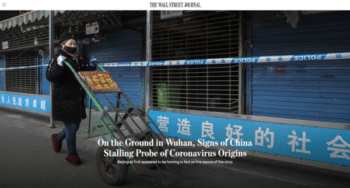
“China has frustrated efforts by foreign officials and researchers to join the hunt” for the origins of the virus that causes COVID-19, the Wall Street Journal (5/12/20) reported.
Under the headline “On the Ground in Wuhan, Signs of China Stalling Probe of Coronavirus Origins” (5/12/20), the Wall Street Journal reported that Beijing was “stalling international efforts to find the source of the virus.” It mentioned that this was occurring “amid an escalating U.S. push to blame China for the pandemic”—”amid” rather than “because of,” as though this might be mere coincidence.
The Journal claimed that the “lack of transparency and international involvement in the search has left room for speculation and blame,” even though Chinese officials have repeatedly explained that the blame game and politicized speculation were why it resisted further transparency and international involvement. The Journal did note:
China isn’t the first country to resist an international investigation of a health crisis on its territory, and its early focus on controlling the virus is understandable, health experts said.
Bloomberg’s report “China Is Making It Harder to Solve the Mystery of How Covid Began” (12/30/20) presented China as a selfish country uninterested in tracing pandemic origins, attempting to silence and punish countries like Australia for merely calling for an independent investigation:
Bloomberg (12/30/20) reported that “the country the novel coronavirus hit first–the place many blame for unleashing the disease on an under-prepared world–now has little incentive to help find the true origin of the greatest public health emergency in a century.”
Where the pathogen first emerged and how it transmitted to humans is a stubborn mystery, one that’s becoming more elusive with each passing month. Before the initial cluster among stall-holders at a produce market in central China, the trail largely goes cold, and the country the novel coronavirus hit first–the place many blame for unleashing the disease on an under-prepared world–now has little incentive to help find the true origin of the greatest public health emergency in a century….
China has ignored appeals for an independent investigation into the virus’s origin, hammering Australia with trade restrictions after it called for one. It’s also stalled efforts by the World Health Organization to get top infectious diseases experts into Wuhan this year.
A Washington Post editorial, “We’re Still Missing the Origin Story of This Pandemic. China Is Sitting on the Answers” (2/5/21), laid out many of the frequent suspicions, questions and demands the U.S. government, and much of U.S. media, have towards China:
What is China trying to hide about the origins of the pandemic—and why?
If the WIV had no role in sparking the outbreak, it should be relatively straightforward for Dr. Shi [Zhengli] to safely open up the databases to scientists so they can properly understand the evolutionary origins of SARS-CoV-2. The institute should provide all records regarding bat samples, viruses and sequences, with verified information provenance, and eventually, it should be disclosed to all.
‘Weapons inspector’ powers
However, the innocent-sounding Australian request for an independent investigation was actually a startling call for giving the WHO, or another international body, “powers equivalent to those of a weapons inspector” to investigate the outbreak (Australia Broadcasting Corporation, 4/22/20, 5/20/20). By invoking such inflammatory rhetoric, Prime Minister Scott Morrison unavoidably brought to mind familiar stories like the invasion of Iraq, launched on the basis of false U.S./UK accusations that it possessed weapons of mass destruction, even after weapons inspectors found no evidence of any (Los Angeles Times, 10/23/02; FAIR.org, 3/19/07; Extra!, 4/06).
This was occurring as the Trump administration was hyping up its propaganda campaign to blame and punish China for the pandemic, in efforts to sue Beijing for damages and reparations (New York Times, 5/3/20). It’s no wonder the Chinese government viewed Morrison’s statements as a political accusation, rather than a good-faith scientific effort to trace the pandemic’s origins.
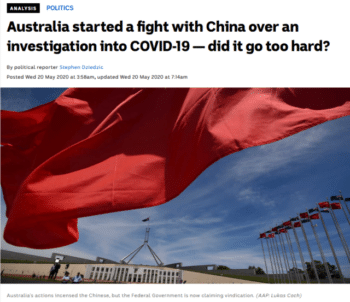
Australia’s ABC (5/20/20) reported that “the Chinese Government was—predictably—incensed” when the Australian prime minister demanded “tough new ‘weapons inspector’ powers to investigate what caused the outbreak.”
Australia’s ABC (5/20/20) noted that China declared that it was always willing to agree to a “scientific investigation.” This seems to be corroborated by China’s agreement on May 18, 2021, to an investigation at the World Health Assembly (WHA) in Geneva, as soon as the hostile rhetoric was toned down, and when certain compromises (such as not granting the WHO new “weapons inspector” powers) were made on the WHA’s motion. Some compromises included assurances that China won’t be expected to take blame for the pandemic, along with the investigation not operating under a presumption of guilt, and occurring after the pandemic is brought under control (Business Insider, 5/19/20).
WHO manipulation conspiracy theories
The WHO’s credibility has also been subject to both U.S. government and media politicization. As part of its China-blaming propaganda, the Trump administration pushed a baseless conspiracy theory that the WHO was under the corrupting influence of Chinese money, simply because the organization delivered conclusions Trump disliked. Some U.S. media outlets helped lend legitimacy to Trump’s claims, as he used them to justify suspending U.S. support for the organization (FAIR.org, 6/21/20).
The New York Times report, “In Hunt for Virus Source, WHO Let China Take Charge” (11/2/20), continued that media habit even months later. As evidence, the paper pointed to the WHO praising China’s undeniably excellent pandemic response—as judged by multiple independent science journals—while refusing to applaud the Trump administration’s objectively horrible performance:
The WHO’s staunchest defenders note that, by the nature of its constitution, it is beholden to the countries that finance it. And it is hardly the only international body bending to China’s might. But even many of its supporters have been frustrated by the organization’s secrecy, its public praise for China and its quiet concessions.
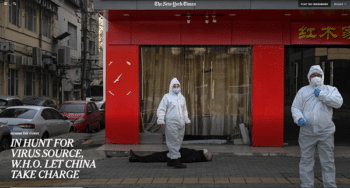
The New York Times (11/2/20) accused WHO of “bending to China’s might” because it “heaped praise on the Chinese government”—as though containing the outbreak within three months of the disease’s discovery were not a spectacular achievement.
The Times insinuated that the WHO was being manipulated by Chinese money, even though the U.S. is the organization’s largest donor, contributing more than 10 times ($893 million) as much as China ($86 million) before the Trump administration vindictively suspended funding last April. In fact, some scientists argue that WHO Director General Tedros has “capitulated” to the “enormous pressure” of the “barrage of political and media commentary,” and is unduly influenced by the U.S. (Science, 7/17/21). Yet questions about the WHO’s credibility only seem to travel in one direction in U.S. media, with suspicions being raised only when the organization distances itself from the lab leak theory.
The Times attributed China’s delay to some innate or exceptional Chinese preference for secrecy and authoritarianism, claiming China’s “authoritarian leaders want to constrain” the WHO, and have “impeded” the effort for an independent investigation because they’re “notoriously allergic to outside scrutiny.” The Times resorted to these thought-terminating stereotypes as explanations for the months-long delay—omitting any mention of Australia’s provocative call for new “weapons inspector” powers to investigate China, or of other countries who also sensibly prioritized containing the pandemic within their borders before investigating pandemic origins. The Times‘ insinuations survived the paper’s admission that the probe was delayed due to the Trump administration’s illegal withdrawal from the WHO:
No date has been set for a visit, though diplomats say China and the health organization appear eager to pause until after the American election. Joseph R. Biden Jr., the Democratic nominee, has said he will keep the U.S. in the organization if he wins.
Sham investigation or sound science?
It’s true that the first phase of investigation into Covid’s origins wasn’t conducted with maximum possible transparency. The Wall Street Journal (2/12/21, 5/23/21) has reported that WHO investigators were denied raw data, or original safety logs and lab records, on the WIV’s extensive work with bat coronaviruses, or to a Wuhan blood bank to test samples from before December 2019 for COVID-19 antibodies. They were, however, provided extensive summaries and analyses of that data by Chinese scientists and officials.
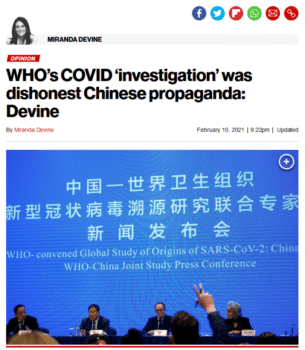
The New York Post‘s Miranda Devine (2/10/21) responded to WHO’s finding that a lab leak was “extremely unlikely” by saying, “Maybe a spaceship from Mars dropped off the coronavirus in Wuhan.”
But corporate media coverage of the investigation implied that the results were suspect, simply because its parameters were set by the Chinese government in cooperation with the WHO, or because WHO investigators didn’t receive unfettered access to all information they wanted in Wuhan.
A New York Post op-ed (2/10/21) by Miranda Devine argued:
WHO conducted a fake investigation from the start, with a team of experts vetted by Beijing and a pre-planned conclusion designed to take the heat off China.
Any report produced by them is a waste of time. It is Chinese Communist Party propaganda that only exposes how fatally compromised by China WHO has become.
A Wall Street Journal op-ed, “The World Needs a Real Investigation Into the Origins of COVID-19” (1/15/21), implied that the probe was a sham because it was not investigating the lab leak scenario seriously enough, instead focusing on a natural origin—as though not treating both with equal gravity was ridiculous rather than based on scientific rationale:
The world needs an inquiry that considers not just natural origins but the possibility that SARS-CoV-2, the virus that causes COVID-19, escaped from a laboratory. The WHO team, however, plans to build on reports by Chinese scientists rather than mount an independent investigation….
The WHO team includes experts who traced the origins of Ebola and MERS outbreaks, but critics are concerned that it doesn’t have the expertise for an investigation that would examine possible lab origins.
A peer-reviewed pre-proof by over 20 of the world’s eminent virologists noted that “all previous human coronaviruses have zoonotic origins, as have the vast majority of human viruses,” and that aside from the 1977 A/H1N1 influenza pandemic that likely originated from a large-scale vaccine trial, “No epidemic has been caused by the escape of a novel virus and there is no data to suggest that the WIV—or any other laboratory—was working on SARS-CoV-2, or any virus close enough to be the progenitor, prior to the COVID-19 pandemic.” It also noted:
Known laboratory outbreaks have been traced to both workplace and family contacts of index cases and to the laboratory of origin. Despite extensive contact tracing of early cases during the COVID-19 pandemic, there have been no reported cases related to any laboratory staff at the WIV and all staff in the laboratory of Dr. Shi Zhengli were reported to be seronegative for SARS-CoV-2 when tested in March 2020.
Whose burden of proof?
The New York Times’ “A Top Virologist in China, at Center of a Pandemic Storm, Speaks Out” (6/14/21) made it clear that a major component of the lab leak speculations depends on rejecting the credibility of Chinese scientists at the WIV. They described Shi Zhengli as “the key to whether the world will ever learn if the virus behind the devastating COVID-19 pandemic escaped from a Chinese lab.” She finds herself, according to the Times, in the predicament of having to defend the “reputation of her lab and, by extension, that of her country.”
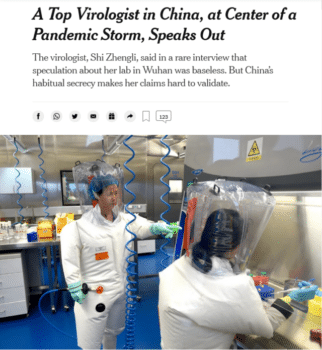
The New York Times (6/14/21) casts doubt on the assurances of Dr. Shi Zhengli because of “China’s habitual secrecy.” The fact that the U.S. government keeps many secrets—including ones related to biological research—doesn’t move the Times to be similarly mistrustful of any scientist with a U.S. nationality.
The Times blamed “China’s refusal to allow an independent investigation into her lab, or to share data on its research,” for making it “difficult to validate Dr. Shi’s claims,” which “has only fueled nagging suspicions about how the pandemic could have taken hold in the same city that hosts an institute known for its work on bat coronaviruses.” But the Times did not question whether lab leak proponents had provided enough evidence to justify such “nagging suspicions.”
The Times noted Shi’s frustration at the burden of proof being placed on her to prove a negative, rather than on WIV accusers to provide evidence of a lab leak:
“How on earth can I offer up evidence for something where there is no evidence?” she said, her voice rising in anger during the brief, unscheduled conversation. “I don’t know how the world has come to this, constantly pouring filth on an innocent scientist,” she wrote in a text message.
Yet when media outlets omit plausible rationales for China resisting further cooperation with an international investigation, it becomes easier for their audiences to leap to the conclusion that China must be hiding evidence of a lab leak.
Typical national security concerns
In fact, it’s doubtful that any country would grant unrestricted access to the data from one of its top biolabs on the basis of the coincidence that the lab was located near where a pathogen was first detected. Such proximity is actually not strong evidence at all, considering that virology labs tend to specialize in the viruses found naturally around them. It seems especially unlikely other nations would grant unfettered access to a facility with a BSL-4 laboratory, since such facilities operate with heightened secrecy due to the national security risks of the dangerous pathogens they research, as the Washington Post (6/22/21) reported:
The events have shined a light on a research niche that—in China, the United States and elsewhere–operates with heightened secrecy because of the national security risks of handling deadly pathogens….
The precautions don’t mean the lab has anything to do with the virus’s origin, or that there’s anything nefarious about its classified projects. The United States also conducts classified pathogen research, and requires employees of high-containment labs to pass background checks.
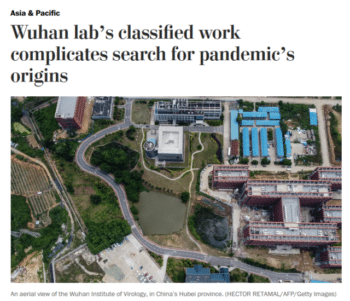
This Washington Post (6/22/21) article makes clear that the WIV’s security “precautions don’t mean the lab has anything to do with the virus’s origin, or that there’s anything nefarious about its classified projects.”
The Post‘s Eva Dou cited virologist Angela Rasmussen explaining:
If the pandemic had started in the DC area, you can count on the fact that the U.S. government would not allow an unfettered “independent” investigation to occur for the exact same reasons: It is a major longer-term security risk that can’t be fully mitigated…. It does not indicate the need to cover anything up, beyond not letting potential adversarial powers have carte blanche access to secure government facilities.
The U.S. is not alone in politicizing the pandemic; China is also guilty of irresponsibly spreading conspiracy theories regarding the Fort Detrick laboratory in Maryland researching dangerous pathogens being the origin of the pandemic. Chinese media often cite the Maryland lab’s shutdown over safety concerns in the summer of 2019, and the coincidence of reports of a mysterious respiratory illness circulating in northern Virginia around the same time—before the coronavirus was first detected in Wuhan—as well as the U.S. military’s presence in Wuhan during October 2019 for its military games (Global Times, 6/28/21).
The U.S. response has been to reject any international investigation for the exact same reasons China gives for denying further WIV inspection. But when they come from the U.S., they are reported without any objections from outlets like the Journal:
Most scientists say they have seen nothing to corroborate the idea that the virus came from a U.S. military lab, and the White House has said there are no credible reasons to investigate it.
Lack of incentive for access
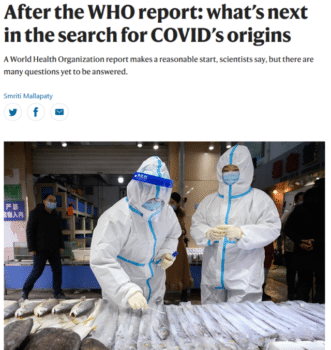
Would “other highly industrialized countries” allow the kind of access demanded of China? Nature (6/5/20) “ I am not sure they would,” epidemiologist David Heymann told Nature (6/5/20).
This is why epidemiologists like Dr. David Heymann (Nature, 4/1/21) have said that the fact China would allow an investigation at all is unusual, and possibly a sign of greater transparency from China than other developed countries, since he is “not sure” whether “other highly industrialized countries” would do the same. Frank Hamill (Nature, 6/5/20)—who previously managed a BSL-4 lab in the U.S.—stated that it would be a “bit hypocritical” to “ask the Wuhan institute to open up its files and let people starting poking around,” given that (as Nature put it) “U.S. biosecurity laboratories are far from fully transparent about their own research.”
Dr. David Gorski, managing editor of Science-Based Medicine (5/31/21), asked:
What country would welcome investigators with open arms into one of their major research institutions to look for evidence that its scientists had screwed up and caused a major disaster? Even if a government were confident that no such error had occurred, it might not be too thrilled with such an investigation, particularly when it’s coupled with what can only be called accusations of wrongdoing and being instigated by people hostile to you. That the Chinese are testy and unenthusiastic about cooperating is not a strong argument in favor of a lab leak. Sure, it could be a sign of a coverup, but it could also just be a normal reaction to accusations.
Foreign Policy’s deputy editor James Palmer (6/9/21) offered yet another plausible reason:
Nor is there any domestic public demand to cooperate on an investigation. Consider how the accusations over a supposed lab leak look from the perspective of ordinary Chinese people. Doctors and scientists who worked on coronaviruses are being painted as co-conspirators in the outbreak. And a country that utterly botched its pandemic response and that often refuses to participate in international accountability itself is making accusations against one that succeeded—driven in part by the politicians involved in that failure.
Yet another reason why China wouldn’t agree to further investigation—even if they’re confident no lab leak occurred—is that an investigation is only politically worthwhile when exoneration is a realistic possibility, but many virologists admit that a lab leak “may be near impossible to falsify” anyway, due to the inherent difficulties of proving a negative.
Australian journalist Caitlin Johnstone (6/8/21) also argued that China has no incentive to open itself up to more opportunities for bad press when Western media would follow the U.S.’s lead in taking every opening to produce their desired anti-China narrative:
Beijing would be absolutely insane to open its doors to such an investigation, because it would have no way of preventing the U.S. and its lackeys from manipulating the results and producing a narrative which fully incriminates the Chinese government while leaving Washington innocent.
Are her remarks hyperbolic?
Distorting China’s cooperation
While it’s true China hasn’t shown maximal transparency in the way the U.S. demands (and would itself never grant to others), it’s also true that Orientalist narratives of Chinese secrecy and duplicity seem to be predetermined and unfalsifiable narratives for Western media, as is typical of coverage on countries Washington declares to be its Official Enemies.
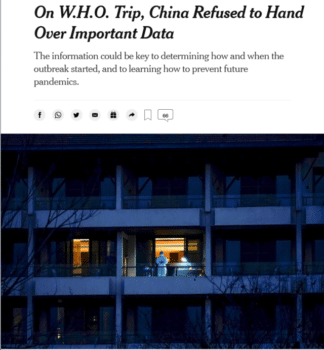
Two scientists complained that their views were misrepresented in this New York Times article (2/12/21), with one saying, “Our quotes are intendedly twisted, casting shadows over important scientific work.”
For instance, the New York Times’ report “On WHO Trip, China Refused to Hand Over Important Data” (2/12/21) was called out for distorting and misrepresenting quotes given by the WHO team members, like Peter Daszak of the EcoHealth Alliance and Danish epidemiologist Thea Kølsen Fischer (MintPress News, 2/15/21). The Times claimed that the scientists said that “China’s continued resistance to revealing information about the early days of the coronavirus outbreak” made it “difficult for them to uncover important clues that could help stop future outbreaks of such dangerous diseases.”
Daszak tweeted in response to the article:
This was NOT my experience on @WHO mission. As lead of animal/environment working group I found trust & openness w/ my China counterparts. We DID get access to critical new data throughout. We DID increase our understanding of likely spillover pathways.
Fischer also tweeted:
This was NOT my experience either on the epidemiological side. We DID build up a good relationship in the Chinese/international epidemiology team! Allowing for heated arguments reflects a deep level of engagement in the room. Our quotes are intendedly twisted, casting shadows over important scientific work.
The Times report is especially suspect for insisting on the narrative of Chinese uncooperativeness, as it came less than a week after an Associated Press (2/7/21) interview with Daszak in which he testified that the Chinese side “granted full access to all sites and personnel they requested—a level of openness that even he hadn’t expected.”
Rejecting Sinophobic premises
FAIR has documented how U.S. media have politicized the pandemic from the beginning, prioritizing condemnation of China’s political system, scapegoating China for the U.S.’s disastrous handling of the pandemic (3/24/20) and alleging Chinese dishonesty without evidence (4/2/20)—all of which has stoked a surge in anti-Asian racism (3/6/20).
Media constantly repeat the repeatedly debunked myth of China punishing “whistleblower doctors” like Dr. Li Wenliang, and other falsehoods like the Chinese government denying that there was any human-to-human transmission of SARS-CoV-2 before January 20, 2020, or needlessly delaying the release of the SARS-CoV-2 genome (FAIR.org, 10/14/20; CGTN, 4/23/20, 8/22/20).
I also pointed out (FAIR.org, 1/20/21) that Dr. Zhang Jixian, the first doctor to report SARS-CoV-2 to health authorities, was rewarded for coming forward. U.S. corporate media outlets, however, generally omit her contribution to the world’s discovery of the virus, which would greatly complicate the narrative of a Chinese “coverup.”
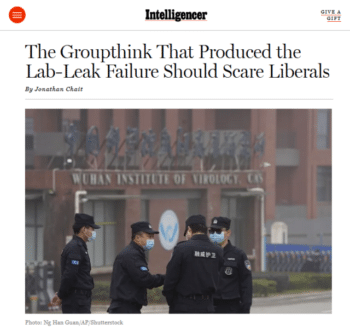
The “lab-leak failure” that New York‘s Jonathan Chait (6/3/21) refers to is corporate media’s initial “failure” to give sufficient credence to an evidence-free conspiracy theory.
This China-vilifying pandemic coverage unsurprisingly extends to the search for the virus’s origins. Although the lab leak hypothesis is often presented by its proponents as a solely scientific inquiry that has been unfairly dismissed for political reasons, in a seemingly innocuous “just-asking-questions” fashion (Salon, 4/24/20; New York, 1/4/21, 6/3/21), this couldn’t be farther from the truth. The lab leak hypothesis is, in fact, a literal conspiracy theory that is gaining traction due to constant media innuendo.
WIV’s Shi Zhengli has testified that her laboratory never had SARS-CoV-2 prior to first receiving patient samples on December 30, 2019, after the virus was first reported by Dr. Zhang Jixian to health authorities on December 27, 2019 (Scientific American, 6/1/20). Early speculations led Shi to declare, “I swear with my life, [the virus] has nothing to do with the lab.”
Shi also affirmed that the WIV has only isolated and grown in culture three bat coronaviruses related to any that infect humans, and these are related to SARS-CoV, not SARS-CoV-2. She says she was never ordered to destroy any viruses after the outbreak surfaced, and that there had been “no pathogen leaks or personnel infection accidents” at the WIV to date (Science, 7/24/20). Shi insists that she would welcome “any kind of visit” to rule out the lab leak theory, claiming she has “nothing to fear,” because she’s confident that she “did nothing wrong.”
If Shi’s testimony is true, the Wuhan lab leak theory cannot be correct, since possessing SARS-CoV-2 in the laboratory prior to the outbreak is a necessary precondition for a lab leak. This is also why any version of the lab leak theory is literally alleging a conspiracy of Chinese scientists lying about their work—along with foreign scientists and officials familiar with their research—in concert with the Chinese government.
Of course, rejecting Sinophobic premises that Chinese people are exceptionally deceptive doesn’t imply the opposite conclusion that Chinese people are incredibly trustworthy; it simply means that the burden of proof is on those alleging Chinese deceit, as it should be for anyone else. Presuming without evidence that WIV scientists are guilty of lying is based on centuries-old Yellow Peril propaganda portraying China as inherently dishonest, coming from a country with a long history of hatred towards Chinese people.
Evidence of actual coverup
But perhaps the biggest irony is that there is evidence of lying by Chinese officials. It’s just that the lying points in the opposite direction of a laboratory origin for SARS-CoV-2.
Since the pandemic began, the Chinese government claimed that the Huanan Seafood Wholesale Market vendors, once suspected to be at the origin of the outbreak, never sold any illegal wildlife. Yet it’s been proven that vendors at the markets linked to some of the earliest COVID-19 cases were illegally selling a range of wildlife in unsanitary conditions, from which the coronavirus may have spread (Bloomberg, 6/7/21). Perhaps the most interesting part of these revelations is that the evidence came from Chinese researchers, from the China West Normal University in Nanchong, who exposed their government’s lies (Nature, 6/7/21).
U.S. corporate media initially used the Huanan Market origin theory to propagate misleading conflations between wildlife markets and “wet markets,” and perpetuated racist stereotypes of Chinese people’s eating habits being especially unsanitary, but the theory was abandoned because the earliest known cases weren’t linked to the market (FAIR.org, 5/7/20). However, recent evidence that illegal wildlife was being sold at the Huanan Market has caused some scientists to believe a zoonotic origin is even more likely than before, and to give the possibility of a Huanan Market origin a second look.
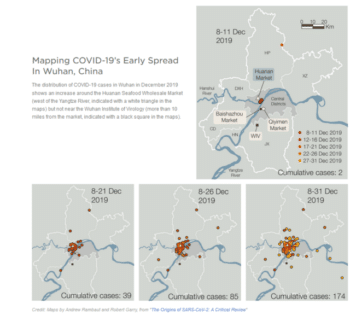
NPR (7/19/21) pointed out that early cases of COVID-19 detected in Wuhan clustered around the market, not around the lab.
Evolutionary biologist Michael Worobey—who signed the open letter calling for a more serious investigation of the WIV—stated “transmission by another species, without a lab escape, is the most likely scenario by a long shot” (NPR, 7/19/21). Worobey even suspects the spillover began at the Huanan Market, though the WHO team concluded it was “more of an amplifying event, rather than necessarily a true ground zero.”
Scientists who mapped out the locations of the earliest Covid cases in Wuhan showed why believing the WIV to be the source of SARS-CoV-2, simply because the virus was first detected in Wuhan, is simplistic. They found that most of the earliest documented cases and excess pneumonia deaths were clustered around the Huanan Market—with “no epidemiological link to any other locality in Wuhan”—with SARS-CoV-2 detected in environmental samples “primarily in the western section that traded in wildlife and domestic animal products.”
Despite concerns about Daszak’s presence on the WHO team, due to his own organization having worked closely with the WIV, he stated, “Don’t think for a minute” the Chinese government “is happy when we repeatedly state that this likely came out of industrial-scale wildlife farming employing 14 million people” (NPR, 3/15/21). Rasmussen, who was not on the WHO team, concurred with Daszak:
The Chinese government has a big incentive to keep this quiet. This is exactly how SARS spilled over. It looks very bad and draws a lot of negative attention to the wildlife trade that the same thing could have happened again.
Resisting bad faith investigations
Despite all the available scientific evidence pointing in favor of a zoonotic origin—and none for a laboratory origin—the Biden administration directed intelligence agencies (not public health experts) to hunt for incriminating documentary evidence showing that Chinese officials were aware of and lied about the virus leaking from the WIV. On August 24, the director of national intelligence presented what the New York Times (8/24/21) described as an “inconclusive initial report” to Biden. But employing the tools of intelligence rather than epidemiology to the questions indicates that the U.S. is promoting lab leak speculations and demanding a political investigation in bad faith. This is especially troubling, considering that 83% of Americans support taking action against China if U.S. intelligence agencies (not the WHO, or scientists capable of conducting a scientific investigation) “reveal” evidence SARS-CoV-2 leaked from the WIV.
It’s true that an apolitical scientific investigation independently checking Chinese claims about the WIV would be ideal, but we should focus on the available evidence, instead of letting the Biden administration falsely present the possibility of SARS-CoV-2 originating in the Wuhan Institute of Virology being “at least as credible as the possibility that it emerged naturally in the wild” (CNN, 7/16/21). A conspiracy to hide a lab leak is a logical possibility, but it’s a near certainty that an Orientalist media would use tropes of an untrustworthy China to turn lack of evidence for a lab leak into evidence of a coverup, with potential results somewhere between distracting and disastrous.
Research assistance: FY Sun

